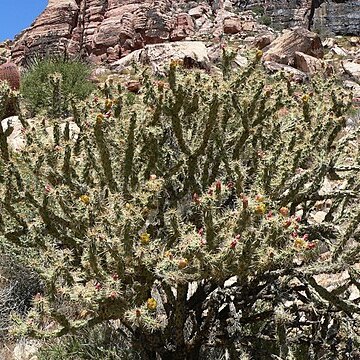Trees or shrubs, sparsely to densely branched, 1-2(-4) m. Stem segments firmly attached, cylindric, 10-30(-50) × 2-2.5(-3) cm; tubercles prominent, narrow to broad, 1.5-4.5 cm; areoles elliptic to subcircular, 4-5.5 × 4-5 mm; wool white or yellowish to tan, aging gray-black. Spines 6-20(-30+) per areole, often accompanied by 0-5 short bristlelike spines at areole margins, usually in distal areoles; major abaxial spines deflexed to divergent, subterete to flattened; major adaxial spines ascending-divergent, terete, yellow or tan to deep red-brown, aging gray, the central spine longest, 12-30(-38) mm; sheaths white to grayish with yellow to golden tips, baggy to tight fitting. Glochids in inconspicuous to small adaxial tuft, yellow to brown, 0.5-2 mm. Flowers: inner tepals bright yellow to bronze to brick red, spatulate, 20-30 mm, apiculate-emarginate; filaments red; anthers yellow; style and stigma lobes white to light green. Fruits tan at maturity, obconic to ellipsoid, 15-35 × 15-20 mm, dry, tuberculate, densely to sparsely spiny (rarely spineless), with apical flange above shallow umbilicus; basal tubercles longest; areoles 12-30. Seeds pale yellow to tan, angular or squarish in outline, warped, 3.5-5 × 3-4.5 mm, sides smooth, each with 2-4 large depressions; girdle smooth.
More
A cactus. A shrubby or tree-like plant. It can have few or many branches. They are 1-4 m long. The stem segments are firmly attached. They are cylinder shaped and 10-50 cm long by 2-3 cm across. The buds are round and have white wool. The small barbed spines are yellow or brown. There are 6-20 spines. The flowers can be red or yellow. They are 2-3 cm long. The fruit are dry and light brown.
Sonoran and Mojave Deserts, desert grasslands, edges of juniper woodlands, rocky slopes and sandy flats; at elevations from 400-1,500 metres.


